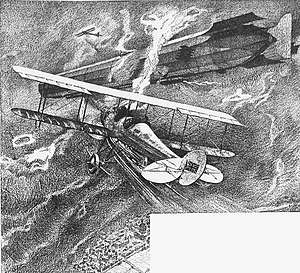Zeppelin LZ 39
The Imperial German Army Zeppelin LZ 39 was an O-class World War I zeppelin.
| LZ 39 | |
|---|---|
 | |
| Imperial German Army Zeppelin LZ 39 under attack. Picture from the 17 May 1915, Night time edition of the Evening Public Ledger [A 1] | |
| Role | O-class reconnaissance-bomber rigid airship |
| National origin | German Empire |
| Manufacturer | Luftschiffbau Zeppelin |
| Designer | Ludwig Dürr |
| First flight | 24 April 1915 |
| Primary user | Imperial German Navy |
| Number built | 1 |
Operational history
Extensively damaged on 17 May 1915 by Flt Commander Bigsworth. Three raids on the western and two on the eastern front, dropping 4,184 kg (9,224 lb) of bombs.
Bigsworth bombing
Flight Commander Arthur Bigsworth had already experimented with night flying, using two 4V lamps attached to his aircraft and no doubt called on this experience on 17 May 1915, when he managed to climb his Avro 504 above Zeppelin LZ39 over Ostend and drop four 20 lb bombs on its envelope, causing considerable damage. LZ39 managed to return to its base, despite damage to five of its gasbags. For this feat Bigsworth was awarded the Distinguished Service Order (DSO). This was the first night-time attack on a Zeppelin.[2] The attack and damage to the Zeppelin was reported on in the American press the same day it happened, 17 May 1915.[1]
Last mission
On 17 December 1915, captained by Dr. Lempertz, LZ 39 was hit by shrapnel during an attack on Rovno. All rear gas cells were punctured and the front engine car was hit and later fell off. The crew abandoned the now-overstressed control cabin, dropped ballast and shifted loads to rebalance the ship and used an emergency control station in the rear to limp back to Germany. After the forced landing the ship collapsed because the material for repair and the supply of gas needed to refill the cells were not available.[3]
Specifications (LZ 39)
Data from Zeppelin : rigid airships 1893-1940[4]
General characteristics
- Crew: 16
- Capacity: 11,100 kg (24,471 lb) typical disposable load
- Length: 161.40 m (529 ft 6 in)
- Diameter: 16 m (52 ft 6 in)
- Fineness ratio: 10.09
- Volume: 24,900 m3 (880,000 cu ft) in 15 gas cells
- Empty weight: 17,800 kg (39,242 lb)
- Useful lift: 28,900 kg (63,700 lb)
- Powerplant: 3 × Maybach CX engines 6-cylinder water-cooled in-line piston engines, 130 kW (180 hp) each
- Propellers: 2-bladed fixed-pitch propellers
Performance
- Maximum speed: 85 km/h (53 mph, 46 kn)
- Range: 3,300 km (2,100 mi, 1,800 nmi) maximum
Notes
- Three Zeppelins were spotted 03:15 on 17 May 1915 with the attack happening after that. Then the British military reported it, sent it out on wire services. The time difference between London and Philadelphia is 5 hrs. The Evening Public Ledger got it on the morning 17 May 1915 commissioned the artist to draw the image who then had it ready for the 17 May 1915 Night Time edition.[1]
References
| Wikimedia Commons has media related to Category:LZ 39. |
- Evening Public Ledger, May 17, 1915, p. 1.
- Hobbs 2017, p. 113.
- Lehmann & Rosendahl 1937, p. CH5.
- Brooks, Peter W. (1992). Zeppelin : rigid airships 1893-1940. Washington, D.C.: Smithsonian Institution Press. pp. 78-80, 204. ISBN 1560982284.
- Hobbs, David (2017). The Royal Navy's Air Service in the Great War. Casemate Publishers. ISBN 9781848323506. Retrieved 17 May 2020.CS1 maint: ref=harv (link) - Total pages: 480
- Lehmann, Ernst August; Rosendahl, Charles Emery (1937). Zeppelin: the story of lighter-than-air craft. Longmans, Green and co.CS1 maint: ref=harv (link) - Total pages: 365
- "Zeppelin Raider in Battle With British Aeroplanes". Evening Public Ledger. Philadelphia, Pennsylvania: Public Ledger Co. 1915. pp. 1–16. ISSN 2151-3945. OCLC 9355469. Retrieved May 17, 2020.